Self-Made Undergraduate STEAM
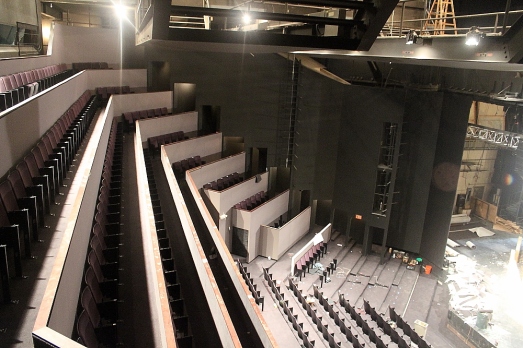
The Rand Theater is the primary performance space that the UMass Amherst Theater Department uses for their large shows, with large amounts of seating and a full array of theatrical aspects including lights, sound, fly rails, removable stage pieces, and a scene shop directly behind it with large bay doors to move scenery back and forth. (Nicholas Calow)
A little while back, I had the pleasure to attend a party at the home of Christine and Sean Doherty in New Hampshire. Christine and Sean (http://www.pointnatural.com), by the way, have each taken a holist approach to science, and both have artistic backgrounds, hers visual, his musical.
While at the party, I was lucky enough to meet Nicholas (Nick) Calow (https://www.linkedin.com/in/ncalow), an undergraduate at UMass Amherst (UMass Amherst). We had a great, if brief, conversation about his academic program, one that he’s put together to address his own strengths and passions. To date, this blog has focused to a large extent on the needs and efforts of university faculty members with regard to arts integration in science teaching, and there was that one post about the few university programs that offer a STEAM focus [link here]. But what about all of those students at universities that don’t offer such programs? How can they negotiate academic programs that address STEAM? This interview with Nick will offer one example.
LD: Hey Nick! So tell me, what year are you at UMass Amherst?
NC: I’m currently a sophomore at UMass, but I expect to be there for five years instead of four because of my double major with Theater and Electrical Engineering.
LD: Okay, so what was behind your decision to do a 5-year double major? Another option, I imagine, would’ve been to do just a single major and maybe a master’s degree later.
NC: My decision came from working over the summer at the Commonwealth Shakespeare Company doing Twelfth Night in Boston Common (http://commshakes.org/). While working there, I saw the type of life theatrical electricians would live, and wanted a bit more than that. I’d already committed to being a theater major, but I figured that an electrical engineering degree on top of that would really help me in the field of design as well as operation. The field I would like to enter is known as stage automation, which is basically using mechanical means to move scenery and lights in a predictable manner, eliminating the human element of scenic manipulation. Since I’d like to design those systems, an engineering degree on top of a theatrical one would be a huge benefit.

M5 is a study and work space for electrical engineering students at UMass Amherst that Nick has used a few times. It has a variety of useful tools and experts in their use who support the students. (Nicholas Calow)
LD: I’ve attended those performances on the Common – wonderful stuff. So your particular intersection of art and science arose from experience in professional theater – I think the real world is often less siloed than the academic world. Is there a typical preparation for stage automation? Would people working in that field have typically have completed a double major similar to yours?
NC:I don’t know many people in the field, but from what I understand many people who are automation techs come from an engineering or a theatrical background, rarely both. A cursory Google search found me this little blurb about it though: http://getinmedia.com/careers/stage-automation-technician. And my plan actually is to design automation systems, so that’s more advanced than being a tech.
LD: Are there logistical challenges that come with this pair of majors – schedule conflicts or expectations of the two departments that don’t fit well together?
NC: There is a large time commitment for both majors, but in very different ways. For engineering, I will need to be doing more homework and tests than hands-on projects, and with theater it is the opposite. When I get higher into both programs, finding enough time for it all will become more of a challenge. Another annoying aspect is the way both majors schedule their classes. With engineering, it is very regular, twice or three times a week for an hour or so, and labs on another day at another time. For theater, there is usually only one or two class times a week, but those times are much longer, and can interfere with the other classes I am taking. As with most college students, I have to be very careful when I make my schedule that nothing overlaps.
LD: So far, have you found any ways to use knowledge or ways of learning/thinking/understanding from one major in courses for the other major?
NC: I haven’t started my engineering major just quite yet, but I can imagine in my lighting and set design classes that knowing advanced math or physics would be of great use. Also, since I’m entering the major at a later date than most would have, I have developed better study skills and time management that some freshmen might not have, which will come in handy once I start being really busy with both majors at the same time.
LD: Do you anticipate doing a project for credit that combines both fields? Is there an option to create your own interdisciplinary directed study or research course? If you did create such a course, would the course have to exist in one department only? Could you have an advisor from each department for that type of course?
NC: In a way, I am already doing something like that. Right now, I am currently working on a project in the theater department under my advisor to utilize an old motor down in the stage trap room to act as a usable piece of technology. Using a bunch of programming that I will be doing myself, my goal is to get the motor to a point where you can interface your laptop computer with it and be able to control every aspect of it; when it starts, how fast it goes, its acceleration, when it stops, and so on. I would imagine that since it’s directed at the stage and solely for the stage, any projects I would do would be based in the theater department, with occasional help by the engineering department.
LD: And what will that motor be used for?
NC: The idea is to use the motor in conjunction with the stage to move large objects through various mechanical means. It could be set under the stage to turn a large rotating platform, it could be attached to a winch to pull a heavy cable on command, it could be used with a pulley to move something across the stage, and so on. After I complete this project, I plan to continue creating a toolbox of sorts for the theater department, learning and improving as I go.
LD: Do you know any other undergraduates who are bridging the divide between art/design and science/engineering/math in their studies?
NC: I’ve found that people who do bridge the gap between art and science are the exception, not the rule. There may be some in assorted examples, but people tend to be in either one or the other, not both. There can be many benefits to what I’m doing with it, as it is guiding and shaping me as I go along, but it also is taking me an extra year to graduate.
LD: Thanks, Nick! It’s been a real pleasure. Please keep me updated on your progress so that we may share it here.
A Scientist in an Art Museum
I’m taking my sabbatical as Scientist-in-Residence at the Peabody Essex Museum (http://www.pem.org). You may ask, what could a scientist possibly have to do in a museum of art and culture? Quite a lot, it turns out. In fact, I could be kept busy for decades with the projects I’ve envisioned. More on that later.
Today I’d like to discuss the following question, one that has come up in my discussions with the education folks at the museum: Where exactly lies the intersection of art and the natural sciences?
I would argue that the crux may be found in observation. Read this quote by Lane Cooper, highly-regarded English educator from his book Louis Agassiz: Illustrative Extracts on his Method of Instruction (1917):
“It is simply the fact that, reduced to the simplest terms, there is but a single method of investigating the objects of natural science and the productions of human genius. We study a poem, the work of man’s art, in the same way that Agassiz made Shaler study a fish, the work of God’s art; the object in either case is to discover the relation between form or structure and function or essential effect. It was no chance utterance of Agassiz when he said that a year or two of natural history, studied as he understood it, would give the best kind of training for any other sort of mental work.”
While Cooper compared the study of literature to the study of natural history, the same comparison holds for the visual arts and any natural science. Seeing requires time and focus. The more we look the more we see, the more we find the extraordinary in the ordinary, and the more clearly we can identify the relationship between form and function. We must always give our students ample time to observe and then ask, What Do You See?
Electric Firefly
I first met the fabulous China Blue at the 2013 Darwin Festival (http://w3.salemstate.edu/~pkelly/darwin/). My colleague, Dr. Susan Case, organizes the festival and alerted me to the fact that this ground-breaking artist would be in attendance. She’d noted that China Blue’s work sits nicely at that intersection of art and science, where my own interests lie, and thought we might have something to discuss. It turned out that we did. A visit to her Firefly Grove installation at the John Brown House in Providence, Rhode Island, inspired our discussion below.
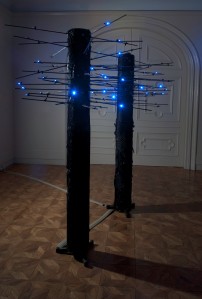 LD: Hi China Blue! That was a great visit we had – great food, amazing dinner conversation, and then a visit to your public art exhibit, Firefly Grove. You’ve written that this piece addresses public concern about the loss of fireflies, but there are so many threatened and endangered species. As a conservation biologist with an interest in the process of setting conservation priorities I wonder – why have fireflies in particular been a focus of your efforts?
LD: Hi China Blue! That was a great visit we had – great food, amazing dinner conversation, and then a visit to your public art exhibit, Firefly Grove. You’ve written that this piece addresses public concern about the loss of fireflies, but there are so many threatened and endangered species. As a conservation biologist with an interest in the process of setting conservation priorities I wonder – why have fireflies in particular been a focus of your efforts?
CB: Fireflies have captivated me when I first discovered them on a visit to Italy, many years ago. I did not know they existed until then because their range sadly does not include California, where I come from. About five years ago I was experimenting with electronics, you would not think of electronics and fireflies together but one of the first exercises is to turn on and off an LED. As a sculptor I thought that was very dull and the idea of an LED turning on and off inspired the thought of making an electronic firefly. That lead to a series expanded from one to the field that you saw.
There are many interesting things about fireflies. In addition to providing us with nostalgic memories of childhood experiences collecting them, they are also bioindicators of a loss of habitat and diversity. Additionally they produce chemicals that create their nighttime illumination. One these chemicals is Luciferin. This is a chemical that is now used as a research tool to track cancer cells in the body and illuminate neuronal pathways in the brain.
LD: I grew up with fireflies in my backyard, and I miss them. So, I’m glad they’re a focus of your work! And why were you experimenting with electronics?
CB: My experimentation with electronics evolved out of my development of sound art works. When that began about 20 years ago, I wanted the work to be small, self-contained and without the usage of a computer or large speaker and amplifier systems which were the mode at the time. So, I taught myself how to burn sound files onto EPROM chips to loop the files. I then created small speaker systems for the work I built so I could camouflage the hardware. Finally, I attached movement sensors that would turn the audio on when people walking by. Operating in this way enabled me to create work that could then be played self-sustained in galleries over a sustained periods of time.
As time went by I realized that learning how to build circuits would be helpful to me in developing new work so that is how I ended up experimenting with electronics.
LD: So, did your work with electronics change the way you thought about the biology? Or did the biology affect the way you understood or approached your art?
CB: It was a bit of both. I did not have a strong education in science because my degrees are in art, so considering science as a topic for my work has been a slow but organic process. Through my work making the Firefly 2.0 etc., I developed an interest in biomimicry and how it can effect and influence technological changes in our world. It’s influences are wide ranging from impacting the creation of robotic gate to velcro tape (inspired by burrs) to self healing materials. And by studying fireflies and bioluminescence I was inspired to approach my work from a vantage point that I never thought of before and one that I find has both meaning while illuminating the human condition and our impact on nature.
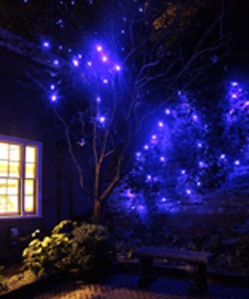 LD: China Blue, this sounds like cutting edge work from lots of interesting angles. I could imagine that it might appeal to undergrads looking for an internship or work-study. Do you ever take on assistants, and if so, what type of work do/would you have them do?
LD: China Blue, this sounds like cutting edge work from lots of interesting angles. I could imagine that it might appeal to undergrads looking for an internship or work-study. Do you ever take on assistants, and if so, what type of work do/would you have them do?
CB: Yes, I often work with interns and assistants. The work I assign is based on a their strengths. One assistant I am currently working with is designing new software for various projects I am working on. His strengths are in knowing a variety of computer languages (MAX/MSP, Ableton Live, Open GL and Java script) and a familiarity with Arduinos and physical computing. Another assistant I had was helpful with running the magazine for my non-profit, The Engine Institute (http://theengineinstitute.org) which requires an interest in art journalism and knowledge of WordPress, MS Word, photoshop and some d-base work. I have also worked with sculptors using new technologies and people familiar with 3d printing.
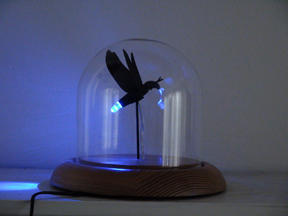 Readers, I hope you enjoyed this little interview, and that it may inspire you to combine art and science in your work. In the process I learned that her work includes not only Animal Behavior, Conservation Biology, electronics, sound engineering, and robots, sculpture and sound art, but also dance! Check out these videos to see and hear her work with Lance Massey and the Providence Ballet Theater (http://www.providenceballet.org/providenceballettheatre.htm ): http://theengineinstitute.org/events. And maybe you can send China Blue some great candidates for an internship!
Readers, I hope you enjoyed this little interview, and that it may inspire you to combine art and science in your work. In the process I learned that her work includes not only Animal Behavior, Conservation Biology, electronics, sound engineering, and robots, sculpture and sound art, but also dance! Check out these videos to see and hear her work with Lance Massey and the Providence Ballet Theater (http://www.providenceballet.org/providenceballettheatre.htm ): http://theengineinstitute.org/events. And maybe you can send China Blue some great candidates for an internship!
Indigo-A-Go-Go
Did you know that there are a seemingly endless numbers of colors of indigo?
The use of natural dyes involves the identification, collection, cultivation and conservation of dye plants, the use of chemistry, including natural mordants/fixatives, fermentation, the art of dyeing, and in many cases, an understanding of local customs and the historical context. Dye plants are often studied along side medicinal plants. In addition to plants, invertebrates and minerals are used sources for dyes. Authentically STEAMy, right???
Here’s link to a nice, older article on the topic, including diagrams some important flavonoid dyes: http://userwww.sfsu.edu/msequin/JCE1981ChemofPlantDyes.pdf
And here’s another to the Facebook page of textile artist Hisaki SUMI. Check out her absolutely gorgeous images! (Thanks, Tani!): https://www.facebook.com/pages/Science-Art-of-Natural-Dyes/129463670414005
Communicable Biology
Once a year or so, I have a biology student who’s a great photographer or illustrator. We talk about scientific photography or scientific illustration as a career path, but I haven’t been able to offer much beyond that. Well, now I can. A colleague just turned me on to this organization, the BioCommunications Association (http://www.bca.org/about/about.html).
From their website:
A typical BCA member is a dedicated, passionate, creative and technical biological/medical photographer, graphic designer, illustrator or videographer employed by hospitals, medical facilities, colleges, universities and research institutions in the life sciences and health care industry.
They offer an education grant: The fund has awarded grants to applicants from several countries for a wide variety of projects such as preparation for certification, attendance at workshops, photographic exhibit support, and the development of new imaging techniques for the microscope. Awards are limited to no more than 33% of available funds for the year and are typically $500 or less. and Any student, trainee, biocommunicator, or institutional program that can demonstrate a need for project funding may apply. So, it’s only $500, but its something.
They also offer a scholarship to support educational opportunities for full-time undergraduate or graduate student pursuing a career in scientific/biomedical visual communications, at an accredited school.
Additionally, they run an annual BioImages competition. Check out their amazing winners gallery here: http://www.bca.org/gallery/bioimages2014salon.html. Be sure to scroll down for the videos!
Last but not least, check out their nicely curated list of links. They include links to academic programs, inspirations and stock images. Maybe I’ll be inspired to branch out from WikiMedia Images.
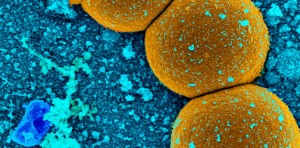
Methicillin-resistant Staphylococcus aureus. A bacteria that causes infections and is one that is resistant to many antibiotics.
Does the Art Have to Be Good, Revisited
So, I’ve been reflecting on my use of the arts to teach biology over the past two years.
My goal is for students to learn the science, not for them to become good artists of any sort. And I can’t teach the arts or design to them beyond the ways in which those arts or design are part of my own training.
I like the use of the arts in learning. The art that’s created doesn’t have to be good art because it isn’t ever presented. For example, students can act out transport through xylem and phloem (the vascular tissue of plants), bring props, include music that’s meaningful to them, and use movement and each other to embody a process that is normally challenging to understand. New, smart scientific questions get asked and answered through experimentation using movement. There’s joy in this learning. And rigor. Shouldn’t these two always go together? If a dance or theatre professor co-taught this exercise, it might be presentable, but otherwise it’s not. Other examples of this type of learning include having students write haikus to gain experience expressing Newtonian physics in their own words, or scientific illustration to encourage close observation.
When the art is integral to the presentation of science, such as the theatre and design aspects of conference-style presentations or scientific presentations to a general audience, student presentations can be greatly improved with the help of some outside resources (acting for science videos – https://stemtosteamihe.wordpress.com/2013/05/11/act-like-you-mean-it/, Edward Tufte’s books – http://www.edwardtufte.com/tufte/).
Aside from scientific presentations, I’m not so sure that I like the use of creative projects as a way to express science learning or communicate science when some of the students lack an arts/design background. The students with formal artistic training can produce really great things, pieces that show rigor from both a scientific and artistic perspective. Those who don’t have that background tend to create pieces that are weak in both fields, suggesting that the science hasn’t been learned or explored sufficiently. Perhaps that’s because the challenge of creating real art is too great and therefore distracting. Creative assignments for those students may do them a real disservice. They could have spent that effort building science skills instead.
Those are my musings for today. Let me know if you think I should change my mind!
Getting the Word Out
Here’s a link to a short article by the Engine Institute, Inc. that mentions my presentation at the New England Faculty Development Conference: http://theengineinstitute.org/moving-from-stem-to-steam
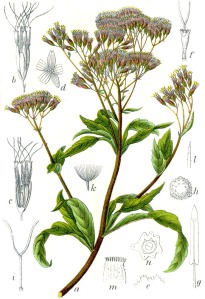
“Eupatorium cannabinum Sturm4” by Johann Georg Sturm (Painter: Jacob Sturm) – Figure from Deutschlands Flora in Abbildungen at http://www.biolib.de
I strongly encourage you to check out the work of the Engine Institute, which aims to foster cross-fertilization of art and science in some pretty innovative ways. Their Executive Director is the fabulous China Blue Wong (http://www.chinablueart.com). I hope to feature her here soon.
A little more press
Check out page 10 for an article on STEAM in Higher Ed by yours truly: http://www.facultymatters.com/spring14/moving-from-stem-to-steam/
Yes, this blog has taken a bit of an unexpected hiatus. I was tapped to develop a new graduate program and that sucked up all of my blogging time, but I’m back and will start writing regular posts again. Plus, I have sweet STEAM sabbatical coming up in the fall, sure to result in lots of juicy ideas. So, stop by about once a week to see what’s new!
A little press
It’s gratifying to see that work in STEAM continues to draw interest. Recently, a University of Phoenix publication featured this blog and the work of several other higher ed folks interested in STEAM including Alan Liu (http://liu.english.ucsb.edu) at the University of California, Santa Barbara, and Michele (http://theatre.msu.edu/index.php/people/faculty/michele-root/) and Robert (https://www.msu.edu/~rootbern/rootbern/Welcome.html) Root-Bernstein of Michigan State University.
See the article here: http://www.facultymatters.com/spring14/moving-from-stem-to-steam/
Artistic Bacteria
Welcome to my first guest post! Today we’re hearing from Dr. Amy Sprenkle (https://www.salemstate.edu/academics/schools/1046.php?id=736) from my home institution, Salem State University (https://www.salemstate.edu).
***************************************************************************************************************
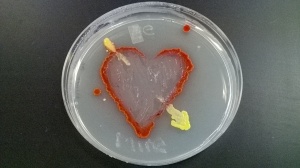
The annual Darwin Festival (http://w3.salemstate.edu/~pkelly/darwin/) coincides with Valentine’s day each year, and I usually invite my microbiology students to create ‘valentines’ by using bacterial cultures that have a macroscopic appearance that is opaque and colorful after growing on an agar plate. This year we shared them at the Darwin Festival.
“But why did you do it?” asked Lisa.
I could come up with many scientific reasons why allowing the students to ‘paint’ with bacteria is a good idea; reminders of the aspects of good aseptic technique, or the study of the interaction of the different cultures as they grow on the plate are just two, but I think the most important reason is that it helps to demystify bacteria, and perhaps break down some ‘germophobe’ walls that have been built in some individuals since childhood. As a microbiologist, I consider germophobes to have a certain lack of intellectual curiosity, and a lack of openness to new ideas, especially in microbiology! 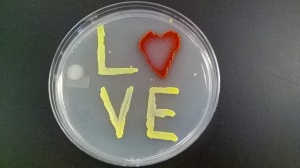
Thinking of bacteria as a medium of art, rather than germs to be feared and removed at all costs, makes manipulating them a lot less scary. Not being assessed on the success of the project also makes it more fun and less threatening
(but many students don’t bother to do the valentine because it’s not required). The best thing in being released from the fear of manipulating bacteria is that it gets one thinking about the ways in which we use microbes to our benefit; in food production and agriculture, bioremediation, biotechnology, and most importantly as a part of our resident microbiota that is so crucial to our health.
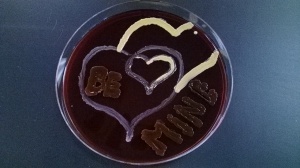 Finally, the delayed gratification that comes with making light ‘brush strokes’ with a sterile toothpick to place microscopic cells on the growth medium, and then to come in the next day and see that your sketch idea has bloomed into color and completion is one that applies to laboratory science and experimentation in general. Just finding out if you like the fine motor manipulation, the suspense of the wait, and the excitement and surprise of the result is a good thing to learn early in career exploration, no? You can find much more of the same on the web here: http://www.microbialart.com/more/
Finally, the delayed gratification that comes with making light ‘brush strokes’ with a sterile toothpick to place microscopic cells on the growth medium, and then to come in the next day and see that your sketch idea has bloomed into color and completion is one that applies to laboratory science and experimentation in general. Just finding out if you like the fine motor manipulation, the suspense of the wait, and the excitement and surprise of the result is a good thing to learn early in career exploration, no? You can find much more of the same on the web here: http://www.microbialart.com/more/

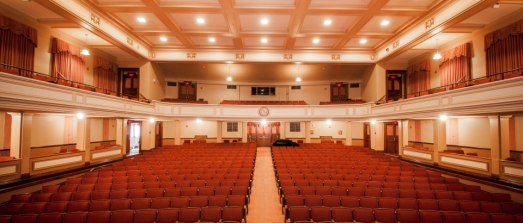
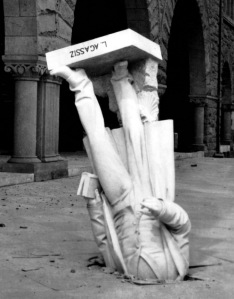
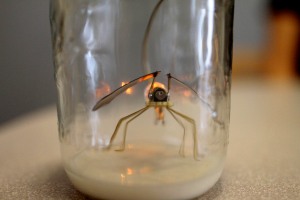
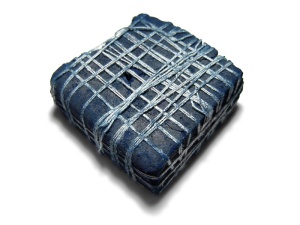

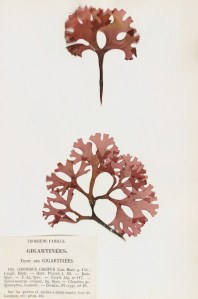

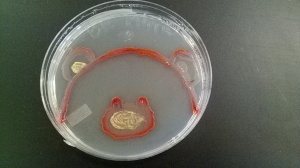
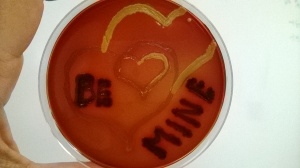
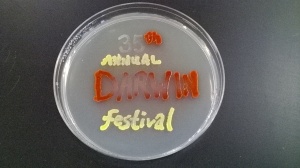
You must be logged in to post a comment.